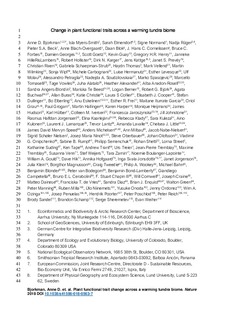| dc.contributor.author | Bjorkman, Anne D. | |
| dc.contributor.author | Myers-Smith, Isla H. | |
| dc.contributor.author | Elmendorf, Sarah C. | |
| dc.contributor.author | Normand, Signe | |
| dc.contributor.author | Rüger, Nadja | |
| dc.contributor.author | Beck, Pieter S. A. | |
| dc.contributor.author | Blach-Overgaard, Anne | |
| dc.contributor.author | Blok, Daan | |
| dc.contributor.author | Cornelissen, J. Hans C. | |
| dc.contributor.author | Forbes, Bruce C. | |
| dc.contributor.author | Georges, Damien | |
| dc.contributor.author | Goetz, Scott J. | |
| dc.contributor.author | Guay, Kevin C. | |
| dc.contributor.author | Henry, Gregory H.R. | |
| dc.contributor.author | HilleRisLambers, Janneke | |
| dc.contributor.author | Hollister, Robert D. | |
| dc.contributor.author | Karger, Dirk N. | |
| dc.contributor.author | Kattge, Jens | |
| dc.contributor.author | Manning, Peter | |
| dc.contributor.author | Prevéy, Janet S. | |
| dc.contributor.author | Rixen, Christian | |
| dc.contributor.author | Schaepman-Strub, Gabriela | |
| dc.contributor.author | Thomas, Haydn J.D. | |
| dc.contributor.author | Vellend, Mark | |
| dc.contributor.author | Wilmking, Martin | |
| dc.contributor.author | Wipf, Sonja | |
| dc.contributor.author | Carbognani, Michele | |
| dc.contributor.author | Hermanutz, Luise | |
| dc.contributor.author | Lévesque, Esther | |
| dc.contributor.author | Molau, Ulf | |
| dc.contributor.author | Petraglia, Alessandro | |
| dc.contributor.author | Soudzilovskaia, Nadejda A. | |
| dc.contributor.author | Spasojevic, Marko J. | |
| dc.contributor.author | Tomaselli, Marcello | |
| dc.contributor.author | Vowles, Tage | |
| dc.contributor.author | Alatalo, Juha M. | |
| dc.contributor.author | Alexander, Heather D. | |
| dc.contributor.author | Anadon-Rosell, Alba | |
| dc.contributor.author | Angers-Blondin, Sandra | |
| dc.contributor.author | te Beest, Mariska | |
| dc.contributor.author | Berner, Logan | |
| dc.contributor.author | Björk, Robert G. | |
| dc.contributor.author | Buchwal, Agata | |
| dc.contributor.author | Buras, Allan | |
| dc.contributor.author | Christie, Katherine | |
| dc.contributor.author | Cooper, Elisabeth J. | |
| dc.contributor.author | Dullinger, Stefan | |
| dc.contributor.author | Elberling, Bo | |
| dc.contributor.author | Eskelinen, Anu | |
| dc.contributor.author | Frei, Esther R. | |
| dc.contributor.author | Grau, Oriol | |
| dc.contributor.author | Grogan, Paul | |
| dc.contributor.author | Hallinger, Martin | |
| dc.contributor.author | Semenschuk, Philipp | |
| dc.contributor.author | Speed, James David Mervyn | |
| dc.contributor.author | Hofgaard, Annika | |
| dc.date.accessioned | 2018-11-15T13:40:23Z | |
| dc.date.available | 2018-11-15T13:40:23Z | |
| dc.date.created | 2018-09-27T21:34:22Z | |
| dc.date.issued | 2018 | |
| dc.identifier.issn | 0028-0836 | |
| dc.identifier.uri | http://hdl.handle.net/11250/2573066 | |
| dc.description.abstract | The tundra is warming more rapidly than any other biome on Earth, and the potential ramifications are far-reaching because of global feedback effects between vegetation and climate. A better understanding of how environmental factors shape plant structure and function is crucial for predicting the consequences of environmental change for ecosystem functioning. Here we explore the biome-wide relationships between temperature, moisture and seven key plant functional traits both across space and over three decades of warming at 117 tundra locations. Spatial temperature–trait relationships were generally strong but soil moisture had a marked influence on the strength and direction of these relationships, highlighting the potentially important influence of changes in water availability on future trait shifts in tundra plant communities. Community height increased with warming across all sites over the past three decades, but other traits lagged far behind predicted rates of change. Our findings highlight the challenge of using space-for-time substitution to predict the functional consequences of future warming and suggest that functions that are tied closely to plant height will experience the most rapid change. They also reveal the strength with which environmental factors shape biotic communities at the coldest extremes of the planet and will help to improve projections of functional changes in tundra ecosystems with climate warming. | nb_NO |
| dc.language.iso | eng | nb_NO |
| dc.title | Plant functional trait change across a warming tundra biome | nb_NO |
| dc.title.alternative | Plant functional trait change across a warming tundra biome | nb_NO |
| dc.type | Journal article | nb_NO |
| dc.type | Peer reviewed | nb_NO |
| dc.description.version | acceptedVersion | nb_NO |
| dc.source.journal | Nature | nb_NO |
| dc.identifier.doi | 10.1038/s41586-018-0563-7 | |
| dc.identifier.cristin | 1615322 | |
| dc.relation.project | Norges forskningsråd: 244557 | nb_NO |
| cristin.unitcode | 7511,2,0,0 | |
| cristin.unitname | Avdeling for terrestrisk økologi | |
| cristin.ispublished | true | |
| cristin.fulltext | postprint | |
| cristin.qualitycode | 2A | |
